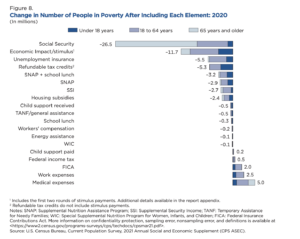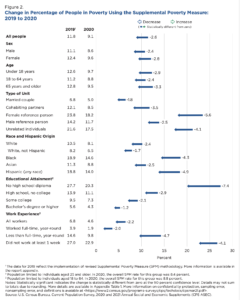Despite New Jersey’s reputation as a high-wealth state, poverty remains pervasive, with roughly 1 in 10 New Jersey residents living in poverty. New Census data show that 871,000 New Jersey residents were living in poverty between 2018 and 2020 based on the Supplemental Poverty Measure, a more comprehensive Census measure of poverty.
Nationally, New Jersey ranks 25th in the percentage of its population living in poverty. Considering New Jersey residents’ median income is routinely among the top in the nation, its poverty rate shows how inequality remains a large problem in the state.
Bold Public Investments Help Reduce Poverty
Although the poverty figures are three-year estimates, the new data show how the COVID-19 pandemic led to a striking decline in household incomes nationally. With historic job losses and unemployment, many people struggled to make ends meet. However, effective government stimulus programs helped mitigate this economic cost and keep families out of poverty. These programs included: expanded unemployment insurance, direct aid checks, refundable tax credits, suspensions of evictions, and forbearance of mortgage and student loan payments.
Federal stimulus checks alone kept nearly 12 million Americans out of poverty, with millions more helped by expanded unemployment and refundable tax credits (see figure below).

Unfortunately, many of these poverty-reducing programs are ending soon or have already ended, despite continued economic turmoil for New Jersey’s low-income residents. As NJPP’s recent employment report details, the economic hardship caused by the pandemic still weighs heavily on low-wage workers and the unemployed, who are disproportionately Black and Hispanic/Latinx.
And it was precisely these populations for whom the anti-poverty effects of COVID-19 were strongest, reducing the percentage of people in poverty nationally by:
- 7.4 percentage points for those without a high school diploma
- 4.7 percentage points for those who worked part-time or did not have work at least part of the year
- 1.7 percentage points for white, non-Hispanic residents
- 4.3 percentage points for Black residents
- 4.9 percentage points for Hispanic/Latinx residents

Please note that NJPP is presenting poverty data based on the Supplemental Poverty Measure, which more accurately reflects basic needs of households better than the “official” poverty measure:
- The “official” poverty measure compares a family’s cash income to the cost of a minimum food diet from more than 50 years ago, failing to account for other household costs like housing or utilities and failing to adjust for geographic differences.
- The Supplemental Poverty Measure includes a wider range of cash and non-cash benefits and costs, including taxes and tax credits, food assistance, work or medical expenses, and child support, while also accounting for more costs like clothing, shelter, and utilities.
Even the Supplemental Poverty Measure fails to account fully for the high cost of living in New Jersey, as noted in a recent report from Legal Services of New Jersey on the true cost of poverty. Based on the “official” poverty measure, New Jersey’s poverty rate between 2018 and 2020 was 7.6 percent, compared to the Supplemental Poverty Measure of 10.0 percent.
For more information on the supplemental poverty measure, see here>.

